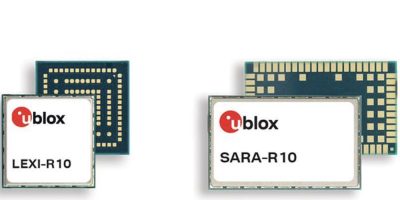u-blox has announced an expansion to its popular range of R10 products for the fast-growing LTE Cat 1bis cellular connectivity market. Predicted by analyst firm Techno Systems Research Co., Ltd to account for 43.6% of all non-handset cellular devices by 2029, LTE Cat 1bis is expected to be the best-selling cellular technology for the Internet of Things (IoT) for the next four to five years. The new modules strengthen u-blox’s LTE Cat 1bis portfolio, serving both the IoT and users migrating from legacy 2G/3G cellular connectivity.
The new u-blox LEXI-R10 Global provides an ultra-compact 16 x16mm LTE Cat 1bis solution that can be used worldwide in size-constrained IoT applications such as people or pet trackers and wearables. The LEXI-R10 Global is the world’s smallest single-mode LTE Cat 1bis module with indoor location and a US MNO certified core.
Meanwhile, the new SARA-R10 series brings the same capabilities as the LEXI-R10 Global to u-blox’s popular SARA form factor. With 2G and 3G sunsets continuing globally, the SARA-R10 offers product designers using 2G and 3G u-blox SARA modules a straightforward upgrade path to 4G LTE – the most widely available global cellular standard today and for many years to come.
The LEXI-R10 and SARA-R10 offer the option to embed an eSIM, and both modules also include an integrated Wi-Fi Sniffer, providing Indoor localisation via the u-blox CellLocate service based on both a Wi-Fi and cellular networks.
One of the variants is the SARA-R10M10, the world’s smallest LTE Cat 1bis module with embedded Global Navigation Satellite System (GNSS) capable of concurrent communication and tracking. It is the ideal solution for asset tracking and telematics applications that demand continuous connectivity as well as indoor and outdoor positioning anywhere in the world, thanks to the blend of GNSS, Wi-Fi scan and global LTE coverage. This module is also 50% smaller than u-blox’s previous LTE Cat 1bis combo, the LENA-R8M10.
The new u-blox R10 modules give product designers a 4G cellular connectivity solution for IoT applications that require medium data rates, worldwide portability, ultra-low power consumption and compact sizes.
Embedded
Microchip adds ECC20x and SHA10x families of secure authentication ICs to TrustFLEX platform
Secure key provisioning is vital to protect sensitive keys against third-party tampering and malicious attacks. For securing consumer, industrial, data centre and medical applications, secure key storage is essential but the process to develop and document secure key provisioning can be complex and costly. To lower the barrier of entry into secure key provisioning and enable more rapid prototyping, Microchip Technology has added the ECC204, SHA104 and SHA105 CryptoAuthentication ICs to its TrustFLEX portfolio of devices, services and tools.
ECC20x and SHA10x ICs are hardware-based, secure storage devices that are designed to keep secret keys hidden from unauthorised attacks. As part of the TrustFLEX platform, ECC204, SHA104 and SHA105 ICs are preconfigured with defined use cases, customisable cryptographic keys and code examples to streamline the development process.
“Adding the ECC20x and SHA10x pre-configured devices to our TrustFLEX platform will facilitate leveraging Microchip’s secure provisioning services for a broader set of applications,” Nuri Dagdeviren, corporate vice president of Microchip’s secure computing group. “With this platform expansion, Microchip is continuing to strengthen its portfolio, making security authentication ICs more accessible and more specifically optimised for high-volume, cost-sensitive applications.”
ECC20x and SHA10x devices meet Common Criteria Joint Interpretation Library (JIL) High rated secure key storage requirements and have been certified by the NIST Entropy Source Validation (ESV) and Cryptographic Algorithm Validation Program (CAVP) in compliance with the Federal Information Processing Standard (FIPS). The secure IC families are designed to implement trusted authentication to maintain the confidentiality, integrity and authenticity of data and communications in a wide range of systems and applications.
Microchip’s CryptoAuthentication ICs are small, low-power devices that are designed to be compatible with any microprocessors (MPUs) or microcontrollers (MCUs). They provide flexible solutions for securing industrial, medical devices, battery powered equipment and disposable applications. Additionally, the ECC204 is a Wireless Power Consortium (WPC) approved Qi authentication Secure Storage Subsystem (SSS).
ECC20x and SHA10x ICs are supported by Microchip’s Trust Platform Design Suite, which provides code examples and learning materials and enables the secure transfer of credentials to more easily leverage Microchip’s secure key provisioning services. The devices are also supported by the MPLAB X Integrated Development Environment (IDE), product-specific evaluation boards and CryptoAuthLib library support.
Microchip introduces a new core in the dsPIC digital signal controller family
Microchip has launched its dsPIC33A Core family of Digital Signal Controllers (DSCs). The ability for engineers to create sophisticated, computationally intensive embedded control algorithms is crucial for achieving superior operational efficiency in motor control, power supply, charging and sensing systems. Built around a 32-bit Central Processing Unit (CPU) architecture with a 200 MHz operating speed, the dsPIC33A family’s advanced core includes a Double-Precision Floating-Point Unit (DP FPU) and DSP instructions for numerically intensive tasks in many closed-loop control algorithms. The dsPIC33A architecture offers high-performance and precise real-time control coupled with a comprehensive development tool ecosystem to streamline and accelerate the design process.
The dsPIC33A DSCs are enhanced with improved maths and data processing, higher code efficiency, faster context switching and reduced latency. This lower latency allows for a faster response time to transient and safety-critical events. New and upgraded peripherals—such as high-resolution PWMs specifically engineered for motor control and digital power conversion—are designed to support progressive technology development in various markets including automotive, industrial, consumer, E-Mobility, data centre and sustainable solutions segments. The dsPIC33A family features integrated analog peripherals, including 12-bit ADCs capable of conversion rates up to 40 Msps, high-speed comparators and operational amplifiers. These analog peripherals, in conjunction with Core Independent Peripherals (CIPs), allow for sophisticated sensing and high-performance control. In addition, the CIPs enable interaction among the peripherals without the need for CPU involvement, enhancing the efficiency of a single controller to manage multiple tasks.
The result is more robust real-time control while reserving the CPU bandwidth for software stacks, functional safety diagnostics and security functions.
The dsPIC33A device families are outfitted with Flash security capabilities, including an Immutable Root of Trust, secure debugging and restricted memory access. The DSCs’ Instruction Set Architecture (ISA) enables the adoption of software code generated by model-based designs to simplify code generation. The combined features make dsPIC33A DSCs well suited for applications that require efficient motor control for fans, pumps and compressors; they also manage digital power conversion for applications like AI servers and on-board chargers in electric vehicles and enable sensor interfacing for industrial and automotive applications.
The first family of dsPIC33AK128MC1xx DSCs includes 128 KB Flash and an extensive peripheral set, offered in various packages, including SSOP, VQFN and TQFP options ranging from 28 to 64 pins, with package dimensions as small as at 4 × 4 mm. Future dsPIC33A families with additional memory, peripherals and larger pin counts will complete the portfolio.
The dsPIC33A family is supported by the MPLAB XC-DSC Compiler, MPLAB Code Configurator (MCC) and the dsPIC33A Curiosity Development Board (EV74H48A). The dsPIC33A Curiosity Development Board supports feature expansion by providing mikroBUS and Xplained Pro interfaces that enable connection to Built-in Self Text Xplained Pro (BIST XPRO) extension kits, sensors and various Click boards. Separate dual In-line modules are available to support development for motor control, digital power conversion and general-purpose embedded applications. For a complete list of dsPIC33A development tools.
Powerful, ultra-small, energy-efficient SMARC SoM from Inelco Hunter
Inelco Hunter has announced the launch of a powerful, ultra-small System-on-Module (SOM) designed for applications demanding compactness and energy efficiency. This SOM leverages the SMARC (Smart Mobility ARChitecture) standard, a widely recognised industry specification for compact, low-power embedded computing applications. Ideal for mobile devices, fleet management, factory automation, medical equipment, portable devices, and industrial IoT applications.
The new module integrates core SOM functions, including SDRAM and Flash memory, within a standardised footprint of 82mm x 50mm. At its core is the robust RK3568 Quad-Core ARM Cortex-A55 CPU, delivering exceptional performance.
The integrated graphics GPU is a Mali-G52-2EE, supporting OpenGL ES 1.1/2.0/3.2, OpenCL 2.0, and Vulkan 1.1, whilst the NPU RKNN Accelerator provides remarkable processing power, up to 1 TOPS. Memory configuration includes 2GB LPDDR4 SDRAM on-board and 16GB eMMC Flash (as the default boot device), with options for 32GB or 64GB.
Supporting up to three displays, the module offers a range of I/O options, including two LVDS or MIPI-DSI ports, one HDMI 2.0 port, and a Display Port. USB connectivity is robust, featuring a USB 3.0 OTG and six USB host ports (five USB 2.0 and one USB 3.0). Additional I/O support is available, with detailed specifications accessible online.
This module supports industry-standard operating systems, including Linux (Buildroot, Yocto, Debian) and Android OS. Inelco Hunter’s engineering and software support ensures rapid implementation, accelerating the customer’s time-to-market.
About Smart Cities
This news story is brought to you by smartcitieselectronics.com, the specialist site dedicated to delivering information about what’s new in the Smart City Electronics industry, with daily news updates, new products and industry news. To stay up-to-date, register to receive our weekly newsletters and keep yourself informed on the latest technology news and new products from around the globe. Simply click this link to register here: Smart Cities Registration






